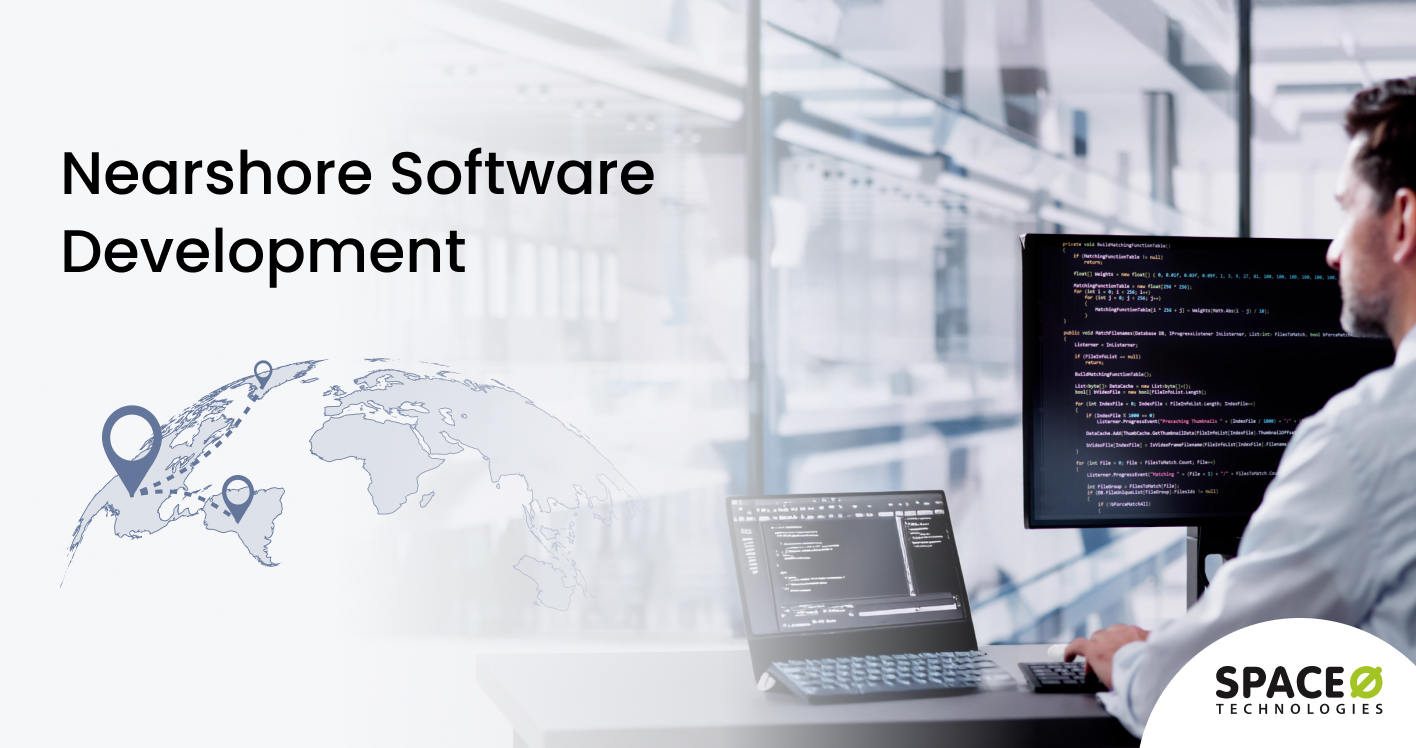Contents
If you have ever dealt with delayed updates, mismatched time zones, or unclear feedback loops while working with an offshore development team, you’re not alone. For many North American startups and growing businesses, these issues slow things down when speed matters most.
That’s where nearshore software development comes in. In 2025, it’s not just about saving money; it’s about working with skilled teams in nearby countries who understand your time zone, culture, and need for faster collaboration.
Since 2010, Space-O Technologies has established itself as a top nearshore software development company. With a portfolio of over 300 custom solutions and 500+ SaaS applications delivered to more than 1,200 clients globally, we’ve honed the art of building and managing efficient remote nearshore development teams.
In this nearshore software development guide, you’ll learn:
- What nearshore development means (and how it compares to offshore and onshore)
- Why more U.S. and Canadian businesses are choosing it
- Cost differences by region
- What to look for in a nearshore development partner
- Common challenges and how to avoid them
- Real examples from companies making nearshoring work
Whether you’re exploring nearshoring for the first time or trying to avoid past mistakes, this guide will help you make a better, more informed decision.
What is Nearshore Software Development?
Nearshore software development means working with a tech team in a nearby country that is close in geography, time zone, and culture.
Think Mexico, Colombia, or Canada if you’re in the US. You collaborate in real time instead of battling 12-hour time differences or late-night Zoom calls. That means faster feedback, fewer miscommunications, and a team that feels more like an extension of yours, not just a vendor.
It’s outsourcing but upgraded for today’s pace and tomorrow’s innovation.
Let’s understand nearshore software development services with an example:
One of the leading US-based fintech startups needs to build a mobile app. Instead of hiring expensive local developers or facing communication barriers with offshore teams in Asia, they chose a nearshore team in Mexico. The result? Faster turnaround, real-time collaboration, and a 40% reduction in development costs.
At Space-O, while our core development center is in India, we work closely with North American clients to mirror the benefits of nearshoring, overlapping work hours, responsive communication, and a U.S.-based point of contact to streamline the entire process.
The next section will explore why more North American companies choose nearshore outsourcing and how you can get the same benefits, even with a globally distributed team.
Want to See How Nearshore Development Can Work For Your Project?
Contact us for a free consultation and explore the best nearshore solution for your business: faster delivery, seamless communication, and cost efficiency.

Why Do Companies Choose Nearshore Software Development?
Businesses are increasingly shifting to nearshore software development for one big reason: it works better for fast-moving nearshore development teams that still want cost control. Here’s why:
Real-time collaboration
No more playing email or Slack tags across time zones. Nearshore teams operate within 1-3 hours of your time zone, so you can review, brainstorm, and iterate fast during your actual workday.
Imagine you’re in New York, and your dev team is in Buenos Aires. It’s 11 AM, and you’ve just spotted a bug in production. You ping the team, and guess what? They’re online and ready to fix it.
That’s the magic of working within a 1–3 hour time zone gap.
With overlapping work hours, you can accelerate your release cycles by 40% because there is no back-and-forth lag due to time zone mismatch.
At Space-O, we are a USA-based company with a development center in India. We align our team’s work hours with US clients to ensure real-time collaboration and daily standups. This gives you the responsiveness of a nearshore team. At the same time, you benefit from the cost advantages of offshore development. In short, it’s nearshore support with offshore benefits.
Cost efficiency without compromise
You get top-tier talent at 30–50% lower costs than hiring locally. No overheads. No HR headaches. Just skilled and reliable nearshore software developers who deliver.
Location Avg Hourly Rate (USD) US Developer $100–$150 Mexico $40–$60 Brazil $35–$55 Colombia $40–$60 Hiring software developers in the US can burn through your budget fast- we’re talking $100–$150/hour fast. Nearshoring offers access to the same level of talent (sometimes better) at nearly half the cost.
For example, a California-based SaaS company can reduce its dev costs by 45% by moving frontend development to a team in Colombia without compromising quality or delivery timelines.
Our India-based team offers even greater savings, often 30–50% below nearshore rates, without sacrificing code quality or communication. That’s what we mean by nearshore experience and offshore cost.
Cultural & communication fit
From agile standups to sprint planning, things just flow better. Most nearshore teams are bilingual, familiar with US work ethics, and trained in international collaboration.
It’s not just about language; it’s about thinking and working the same way. Nearshore teams often have strong English skills, plus experience working with US companies. That means fewer misunderstandings, more explicit expectations, and less hand-holding.
Access to specialized talent
Let’s face it— hiring specialized developers in the US can take 8–12 weeks (or longer). In contrast, reputed nearshore software development companies often have pre-vetted talent ready to plug into your workflow.
Need AI engineers? React experts? DevOps champions? You get deep expertise without waiting months to hire.
Easy & quick team integration
Nearshore partners don’t feel like outsiders. They’re team players who adapt to your tools, culture, and speed, giving you the flexibility to scale up or down fast.
The best nearshore teams don’t feel like freelancers. They sync with your tools, your culture, and your vision. Start with a sprint or two, and scale the relationship as you grow.
For example, a logistics company in Chicago starts with a 3-month contract with a nearshore team in Argentina. By month 2, the team was involved in architecture discussions and product roadmap planning and now handles their entire backend system.
Streamline Your Development Process and Reduce Costs With Nearshore Teams
Contact us today to know we can help you achieve faster turnarounds and better collaboration without the premium onshore rates.
Nearshore vs. Offshore vs. Onshore Development (Comparison Table)
You are not alone if you’ve ever been confused by these buzzwords. On paper, they all sound like ways to get software built by someone outside your immediate team. But the difference matters when deciding where to put your tech dollars and trust.
| Criteria | Nearshore | Offshore | Onshore |
|---|---|---|---|
| Cost | Moderate ($35-$90/hr) | Lowest ($20-$50/hr) | Highest ($100-$150/hr) |
| Time Zone Alignment | High | Low | High |
| Communication Ease | High | Medium-Low | High |
| Tech Talent Quality | High | Medium-High | High |
| Cultural Fit | High | Low | High |
| Project Control & Collaboration | High | Medium | High |
Let’s put the difference into perspective
Think of it like choosing where to eat dinner:
- Onshore is like dining at a five-star restaurant in your city; it is convenient and top quality, but expect to pay a premium.
- Nearshoring is like finding a local gem, exceptional quality, easier communication, and none of the hefty price tags.
- Offshore is like ordering from a highly rated international spot; it may take longer to arrive, and you’ll want to double-check the instructions, but the flavors and value can be amazing if well-managed.
At Space-O, we offer a hybrid model for nearshore software development services:
It means you get the cost benefits of offshore development (with our India-based team) and the reliability of a U.S.-based company, including timezone-aligned collaboration, U.S. project oversight, and real-time communication; in other words: Offshore pricing, nearshore experience, onshore accountability.
How Much Does Nearshore Software Development Cost?
Let’s talk numbers because, at the end of the day, budget matters just as much as quality.
When you are exploring a nearshore software development model for your business, you will notice something pretty encouraging: you get exceptional talent at a fraction of the cost of onshore teams without sacrificing time zones or communication.
Here’s a quick snapshot of average hourly developer rates in popular nearshore regions:
| Country | Average Hourly Rate (USD) |
|---|---|
| Mexico | $40 – $65 |
| Brazil | $35 – $60 |
| Argentina | $35 – $60 |
| Chile | $40 – $65 |
| Costa Rica | $45 – $70 |
| India | $20 – $40 |
Note: Rates are approximate and can vary based on developer experience, project complexity, and specific skill sets.
Key Cost Factors That Influence Nearshore Development Rates
Yes, hourly rates matter. But there’s more behind the final number on your invoice. Here’s what really shapes the cost of your nearshore software development outsourcing so you can make decisions with clarity, not just guesswork.
The talent you need isn’t one-size-fits-all
Hiring a junior developer to build a landing page? That’s one price.
Looking for a senior AI engineer with experience in TensorFlow and NLP? Expect a different ballpark.
The more niche or high-impact the role, the more it costs, and rightfully so. But here’s the upside: investing in the right expertise often means faster delivery, fewer bugs, and less rework. In the long run, that’s cost-efficiency.Engagement model: team or task?
Are you looking to augment your in-house team with a few developers for 3 months? Or do you need a dedicated cross-functional squad for a scaling product?
- Staff Augmentation is flexible and fast, and it is great for short-term projects or for plugging skill gaps.
- Dedicated Teams come with strategic value, long-term alignment, domain expertise, and ownership of outcomes.
The deeper the integration, the more value you extract per dollar spent.
Complexity isn’t just code, it’s strategy, too
Let’s say you’re building a delivery app vs. a fintech platform that requires secure payment gateways, third-party APIs, and GDPR compliance.
- More layers = more planning, QA, iterations, and skilled developers.
- You’re not just paying for coding hours but investing in architectural decisions, compliance know-how, and future-proofing.
Complex projects are more expensive but are also where nearshore teams shine when communication is key.
Not all cities cost the same (Even within the same country)
Nearshoring to Mexico? Great choice. But did you know developer rates in Mexico City may be 15–20% higher than in cities like Guadalajara or Mérida?
- Urban tech hubs often come with a premium.
- But they also bring stronger infrastructure, better language fluency, and access to top-tier dev communities.
Choose based on what matters more to you: cost, experience, or scalability.
Time zone overlap is a hidden money-saver
Ever waited 12 hours for a reply to a simple Slack message?
That’s a hidden cost in delays, misalignment, and slowed-down iterations.
Nearshore teams typically share 6–8 hours of your working day, making collaboration almost seamless.
- Daily stand-ups become real-time.
- Last-minute bug fixes don’t roll into tomorrow.
- Feedback loops tighten.
What looks like a slightly higher hourly rate often translates to weeks saved, and that’s ROI. We at Space-O take daily standups to last-minute bug fixes and stay in step with your U.S. hours, so work happens when you are working, not while you are sleeping.
7 Simple Steps to Choose a Nearshore Software Development Partner
So, you are sold on nearshore software outsourcing. The time zone works. The talent pool is promising. But here’s the big question:
“How do I choose the the right software development partner, someone who actually gets what we’re building and doesn’t just tick boxes?”
Let’s break it down step by step, without the fluff.
Start with strategy, not just budget
Before talking numbers, zoom out. Ask:
- What’s the bigger picture here?
- Are you building a product from scratch?
- Looking to scale fast?
- Or modernize legacy systems?
Your goals shape the kind of partner you need, whether it’s a plug-and-play dev team, end-to-end product builders, or domain-specific consultants.
Clarity here saves months later. A great nearshore partner should ask you these questions before you even sign.
Check their track record, not just the tech stack
Tech skills matter, but they’re just the entry ticket. What really counts is relevant experience.
- Have they delivered solutions in your industry or use case?
- Can they show measurable outcomes, like faster time-to-market, increased app stability, or product adoption?
Say you are a fintech startup building a secure mobile wallet. A partner who’s already navigated compliance in Latin America will deliver faster with fewer surprises.
Gauge how they communicate beyond language fluency
Proximity brings timezone alignment, but what about communication culture?
Hop on a discovery call. Observe how they ask questions, whether they push back on assumptions, and how clearly they explain their process.
Ask: “How do you handle mid-sprint changes?” or “What happens when we hit a blocker?” You’ll quickly learn whether they’re transparent problem-solvers or passive executors.
Meet the team, not just the salesperson
You’re not hiring a logo; you’re trusting a team. So ask to meet them.
- Who will be your day-to-day contacts?
- Are these full-time, in-house nearshore software developers or freelancers?
- Do they offer you continuity or rotate talent across projects?
Many businesses have found success when interviewing nearshore developers or project managers before signing; it sets a collaborative tone from the start.
Look for product thinking, not just coding skills
The best nearshore teams don’t just build what you ask for; they think alongside you.
Do they question the user flow? Suggest better architecture? Flag bottlenecks early?
One US-based SaaS company we know cut their churn rate in half because their nearshore partner proposed a UX change during sprint reviews, something the in-house team hadn’t even noticed.
Run a small pilot before you scale
You don’t need to bet the farm right away. Begin with a trial phase, maybe a 2-4 week sprint or a single feature.
- This lets you validate speed, ownership, communication, and deliverables in a real setting.
- It’s also a great way to assess how both sides adapt when things shift because they will.
Even large enterprises today opt for pilot-based partnerships before committing. It’s not a sign of doubt; it’s a mark of diligence.
Get crystal clear on workflow expectations
Even in a nearshore setup, there are variables, time zones, work culture, and toolsets.
Clarify early on:
- What your daily/weekly sync rhythm will be
- Which platforms will be used for tickets, feedback, and reviews
- What your escalation or issue resolution plan looks like
Most failed projects don’t fail on skills; they fail on unspoken expectations.
Still Not Sure How to Choose the Right Nearshore Partner?
Discuss your project requirements with us, and we will help you make it successful with the right guidance, expertise, and advice.
Nearshore Software Development Challenges & How to Overcome Them
Let’s be real: no development model is challenge-free. Even with all the perks of nearshoring, you’ll still need to navigate some bumps.
But here’s the good news: most hurdles are avoidable if you know where to look. And that’s exactly what this section is about: helping you see around corners before you hit them.
Timezone overlap isn’t always synced as expected
One of the biggest nearshore selling points is overlapping working hours. But depending on daylight savings, regional holidays, or staggered team schedules, those golden hours may not be as generous as promised.
How to overcome it:
- During kickoff, clarify exact collaboration windows (e.g., 10 am – 2 pm EST).
- Align key ceremonies (like daily standups or sprint planning) within those hours.
Use async-friendly tools like Loom, Slack threads, and Notion docs to keep momentum going even when offline.
Communication styles might differ more than you think
You are both fluent in the same language, but tone, response time expectations, and hierarchy in communication can still vary based on regional work culture.
For instance, nearshore developers from some cultures might avoid saying “no” directly, leading to surprises later.How to overcome it:
- Set the tone by encouraging openness and constructive feedback.
- Define what “done” means clearly in each ticket or feature.
- Have regular retros to discuss what’s working and what’s not from both sides.
Legal and IP protection might feel unfamiliar
Different countries, different rules. Things like NDAs, IP ownership, and liability clauses may not carry the same weight across borders, which can feel risky when outsourcing your core product.
How to overcome it:
- Always work with a partner who operates under US-compliant contracts, even if their team is elsewhere.
- Confirm they’ve worked with international clients before and understand cross-border regulations.
- If needed, loop in a legal advisor to review agreements; this is your business, not just code.
Scaling the team quickly can get bottlenecked
You might start with a small team that’s a great fit, but what happens when your roadmap doubles and you need 5 more devs fast?
This is where some nearshore partners fall short if they don’t have strong recruitment pipelines or flexible staffing models.How to overcome it:
- Ask upfront how quickly they can ramp up if needed.
- Look for partners with an internal bench or access to pre-vetted talent pools.
- Define scale-up triggers early (like funding rounds or feature milestones), so hiring doesn’t become a fire drill.
There’s still a perception gap between “Partner” and “Vendor”
You want a strategic partner for developing your own software who shares your vision and thinks beyond tasks. But sometimes, nearshore vendors fall into an order-taking mindset rather than proactive problem-solving.
How to overcome it:
- Set the tone early: bring them into product meetings, share user feedback, and ask for their POV.
- Choose a partner who shows initiative during the sales process; if they ask smart questions now, they’ll add value later.
- Celebrate small wins together. It turns transactions into teamwork.
Cultural integration doesn’t happen overnight
Even if you’re in sync on tools and timelines, there’s often an invisible gap in work culture, humor, decision-making pace, or even how feedback is shared.
How to overcome it:
- Do short team-building sessions virtually; even 30 minutes a month makes a difference.
- Share your team rituals, values, and working style guidelines.
- Encourage a buddy system between in-house and nearshore teammates to build rapport faster.
Ready to Nearshore Smarter in 2025? Let’s Build It Right, Together
The nearshore software development model isn’t just a trend; it’s a practical, faster, and more flexible way to scale your product with skilled talent aligned with your time zone and work culture.
Whether you are a startup building your MVP or a growing business trying to speed up releases, the key is choosing a right custom software development partner who understands your product vision, not just your tech stack.
At Space-O Technologies, we’ve helped over 1,200 clients build high-impact digital products. With a U.S. presence and a development center in India, our nearshore software development team offers a model that blends the collaboration of nearshore with the cost benefits of offshore, giving you the best of both worlds.
This guide on nearshore software development services was just the beginning.
Your next move? Start a conversation with us. Let’s explore what nearshoring can do for your product roadmap in 2025 and beyond.
Frequently Asked Questions
Is nearshore software development only for big companies with large budgets?
Not at all. In fact, nearshoring is a sweet spot for startups and scaling businesses. You get access to top-tier talent, smoother communication, and faster delivery without burning your budget like onshore might. Think of it as smart scaling without the overhead.
How do I know if a nearshore partner truly understands my business needs?
It’s not just about checking their tech stack. During discovery, see how they listen. Do they ask about your long-term goals, user stories, and success metrics? A reliable nearshore development partner isn’t just building code; they’re building your vision, side-by-side.
How do I choose the right nearshore development partner?
To choose the right nearshore software development company, consider the following factors:
- Technical expertise
- Cultural fit
- Communication practices
- Client references
How do I ensure security in a nearshore partnership?
To protect your project, ensure your nearshore partner follows strict data security policies, signs NDAs, and complies with GDPR or HIPAA regulations.
What if I’ve already tried offshore, and it didn’t work out? Will nearshoring be any different?
You’re not alone. Many companies we work with have made the same shift. The difference? Nearshore development teams are closer in time zone, better aligned culturally, and more agile in real-time communication. That means fewer delays, more transparent collaboration, and better results.
How much involvement will I need day-to-day with a nearshore software development team?
You can be as hands-on or hands-off as you want. Clients enjoy structured daily or weekly syncs, shared dashboards, and transparent workflows. With the proper setup, it feels like an extension of your in-house team, minus the HR headaches.
How do I ensure quality control with a nearshore team?
To ensure quality control with a nearshore software development company, make sure you maintain:
- Clear expectations and communication
- Regular code reviews and testing cycles
- Using industry-standard frameworks and tools
Do I need to consider any legal considerations when engaging with a nearshore software development team?
Yes, here are some important legal aspects that you need to consider:
- Intellectual Property Rights: Make sure clear agreements are in place to protect your intellectual property.
- Data Protection Regulations: Verify compliance with relevant data protection laws, such as GDPR.
- Contractual Agreements: Establish comprehensive contracts outlining deliverables, timelines, and dispute resolution mechanisms.



